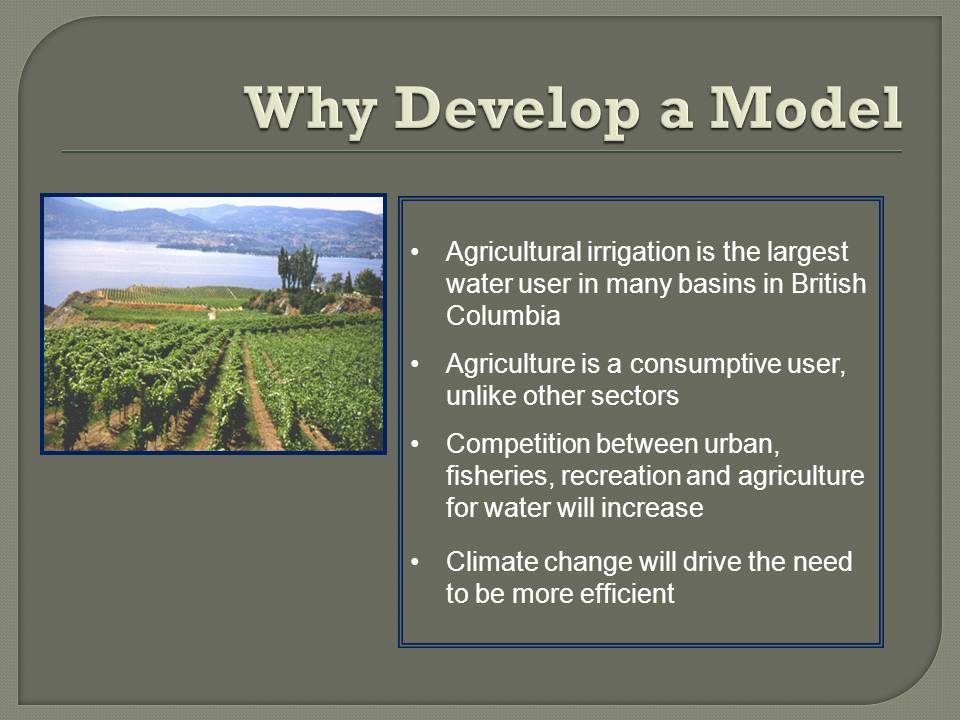Towards Food Security on Vancouver Island: Agricultural Water Demand Model is a Key Tool
Note to Reader:
The “CAVI Forum within the VIEA Summit” will showcase how four regional districts – Capital, Cowichan Valley, Nanaimo and Comox Valley – were brought together as partners in an Inter-Regional Education Initiative; will introduce the Agricultural Water Demand Model initiative, an important first step towards addressing the food security issue; and demonstrate how a balanced approach to water and watershed sustainability is an important building block towards an integrated approach to sustainability and a “Vancouver Island Vision”. The article below provides an overview of the Agricultural Water Demand Model initiative, and its significance.
Model Brings Science to the Table
“Originally developed for the Okanagan Basin, the Agricultural Water Demand Model (AWDM) is currently operational in the Okanagan, Similkameen, Kettle and Nicola regions. We are in the process of expanding it to the Vancouver Island, Fraser Valley and Thompson regions,” reports Ted van der Gulik, Senior Engineer with the Ministry of Agriculture, and AWDM Project Manager.
 “Many BC watersheds are either already fully allocated or will be in the next 15 to 20 years. The model provides information on current agricultural water use and will also determine future use under various climate change scenarios. It will also be used to fulfil the province’s commitment under the Living Water Smart strategy, to reserve water for agricultural lands. It enables scenario comparisons to assess the implications and impacts of a changing climate, in particular warmer winters and longer summers.”
“Many BC watersheds are either already fully allocated or will be in the next 15 to 20 years. The model provides information on current agricultural water use and will also determine future use under various climate change scenarios. It will also be used to fulfil the province’s commitment under the Living Water Smart strategy, to reserve water for agricultural lands. It enables scenario comparisons to assess the implications and impacts of a changing climate, in particular warmer winters and longer summers.”
“The model brings science to the table. It is founded on a GIS database that contains information on cropping, irrigation system type, soils type and climatic data. Information is gathered and verified through on-the ground inventory surveys.”
“The model calculates water demand for each unique combination of crop, soil and irrigation system. A polygon is generated for each combination, a calculation is done for the polygon and then the polygons within a property are added together to determine the water demand for the property. Properties are added together to determine the water demand within a watershed, groundwater region or local government boundary. A daily gridded climate dataset has been developed so that demand can be calculated on a daily basis and then summarized by month or annually. The model can produce one year of data in a matter of minutes.”
Implementation on Vancouver Island
“On Vancouver Island, we have just completed the first year of implementation. This stage of the work involved land use surveys, and was undertaken in partnership with two regional districts – Cowichan Valley and Regional District of Nanaimo – and the Living Rivers Trust. Implementation is being facilitated through the Partnership for Water Sustainability in BC,” continues Ted van der Gulik.
“Implementation goes beyond the agricultural sector. As we have demonstrated in the Okanagan, once the model is built for agricultural lands, it can be used to incorporate the municipal settlement areas. Since the model is GIS-based, the Agricultural Water Demand Model is a tool that can be used to assess TOTAL water demand within a region.”
“In the municipal sector, the corollary to the Agricultural Water Reserve is demonstrating water use efficiency to meet targets set out in Living Water Smart, British Columbia’s Water Plan – for example, by 2020, water use in BC will be 33 percent more efficient; and fifty percent of new municipal water needs will be acquired through conservation by 2020.”
“In municipal settlement areas, the opportunity for be more efficient and reduce water use is outside the home. This is the reason why we have also developed two web-based irrigation scheduling calculators – one for agricultural irrigation, and the other for landscape irrigation in yards and parks. The Water Conservation Calculator, a third web-based decision-support tool, demonstrates how specific water conservation measures can yield both fiscal and physical water savings for communities.”
“Knowing how much water we have now, and how much we will need in the future, is a foundation block in developing a strategy that addresses the food security issue on Vancouver Island. The Agriculture Water Demand Model will be a cornerstone of such a strategy,” concludes Ted van der Guilk.
To Learn More:
Reports about the Okanagan Water Demand Model are posted on the Agriculture & Water community-of-interest on the waterbucket.ca website. To access these reports, click here.
About Ted van der Gulik: He joined the Ministry of Agriculture in 1979. During his time with the Ministry, Ted has built an international reputation for his leading edge work in agricultural water management. This is exemplified by his selection as the Irrigation Association’s 2000 Crawford Reid Memorial Award recipient. The award recognized his work in promoting proper irrigation techniques. Ted has led numerous water projects over the years that have had a large impact not only on individual farms but also on entire communities and watersheds in this province. The many guides and manuals he has written are being used locally and around the world.
Towards Food Security
“The implementation and inclusion in the CAVI strategy of the Agriculture Water Demand model on Vancouver Island is both timely and significant. Food security strategies demand an integrated and focussed approach, reliant upon an efficient and sustainable water supply. The Agriculture Water Demand Model has proven to be an effective tool for calculating irrigation demands, and as a result is enabling long term water sustainability planning to be  effectively implemented in BC,” states Eric Bonham, a founding member of the CAVI Leadership Team.
effectively implemented in BC,” states Eric Bonham, a founding member of the CAVI Leadership Team.
“Food security is an essential component of the CAVI and VIEA 50-year Vancouver Island vision. The uncertainty of the impacts of global warming, combined with the current inadequate food security situation on Vancouver Island, calls for a long term strategy that ensures water security for agriculture purposes, the protection of farmland, the encouragement of local food initiatives, and the support of innovation and diversity in the agricultural industry.”
Posted October 2012





